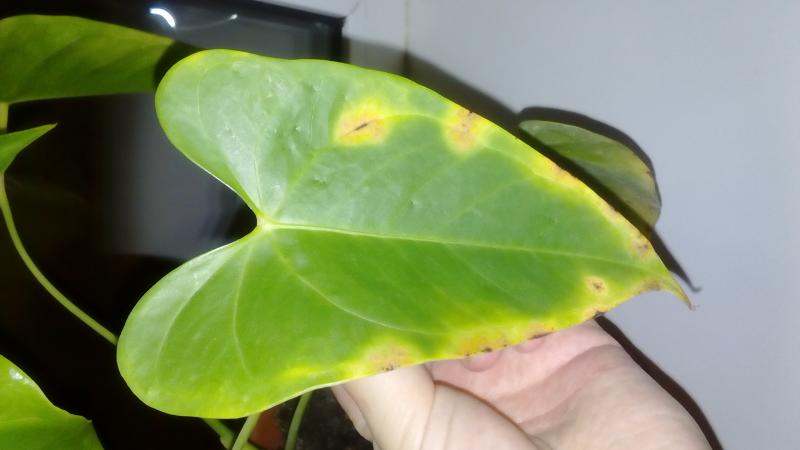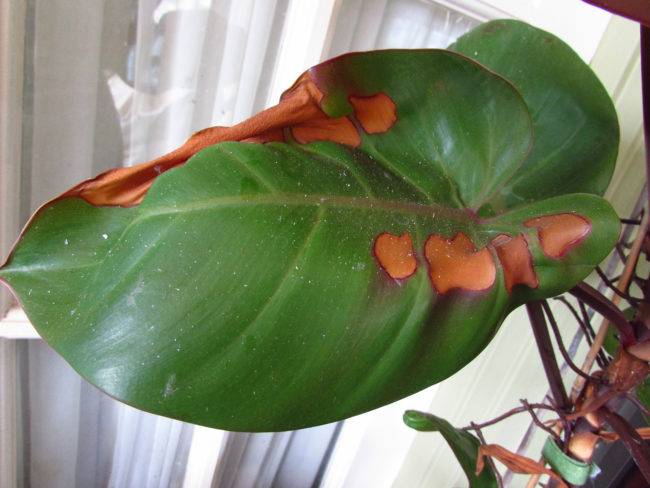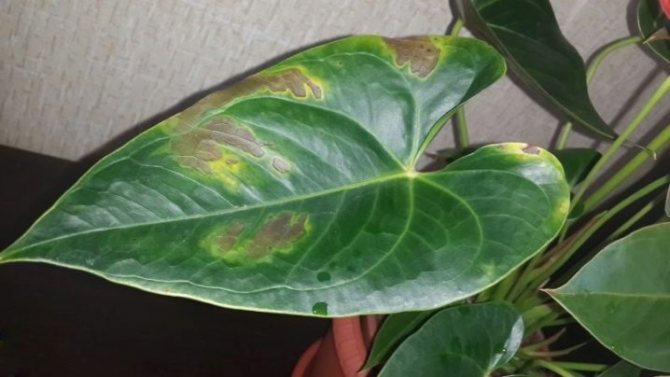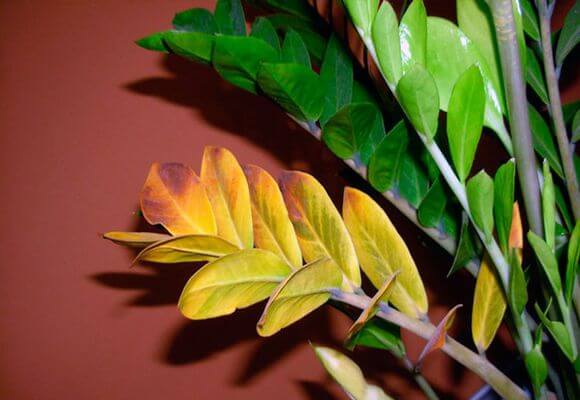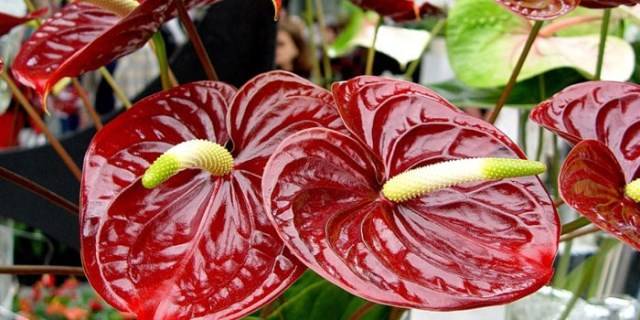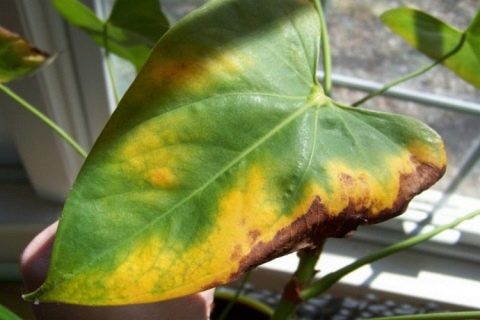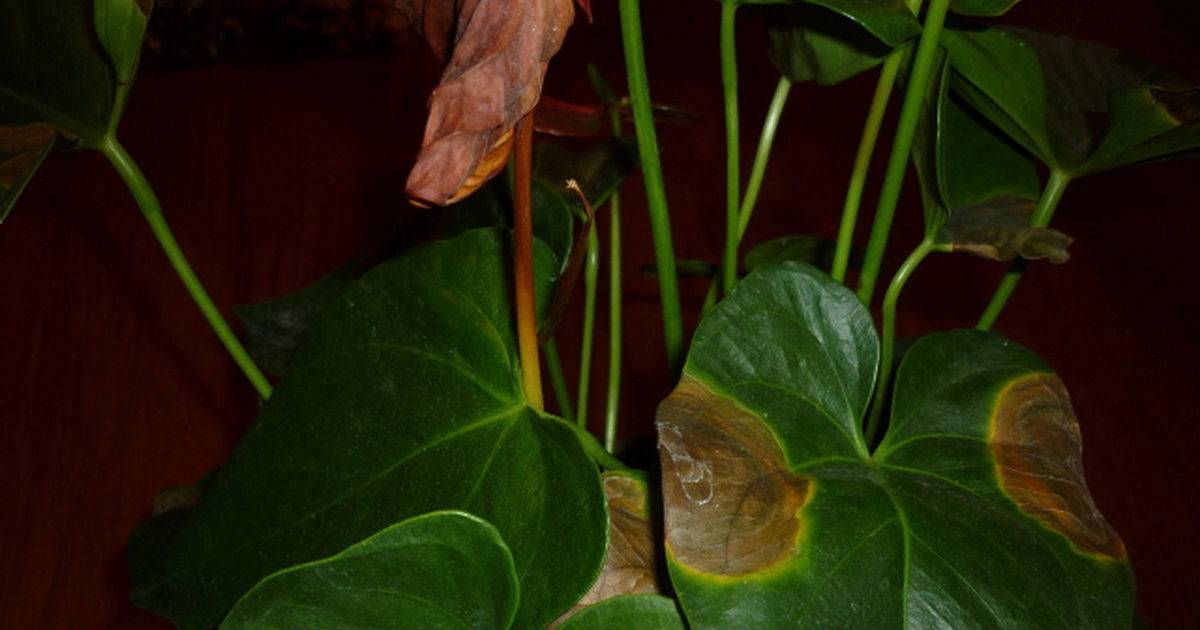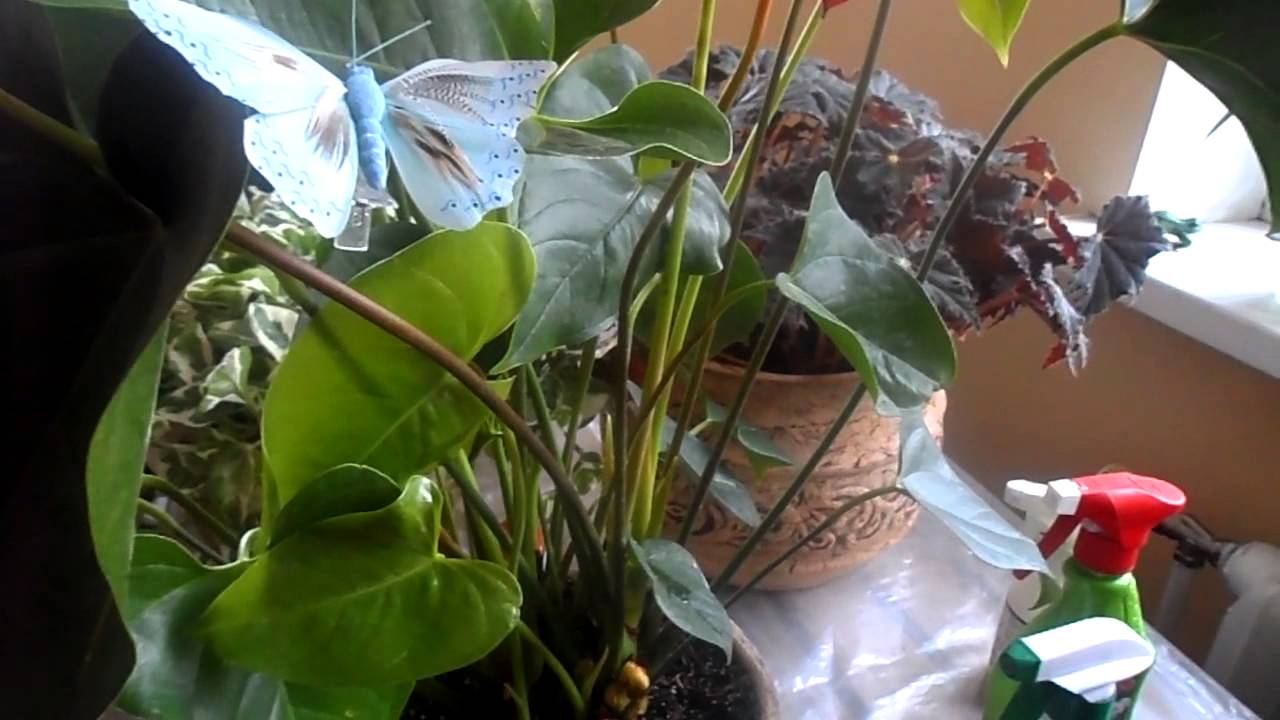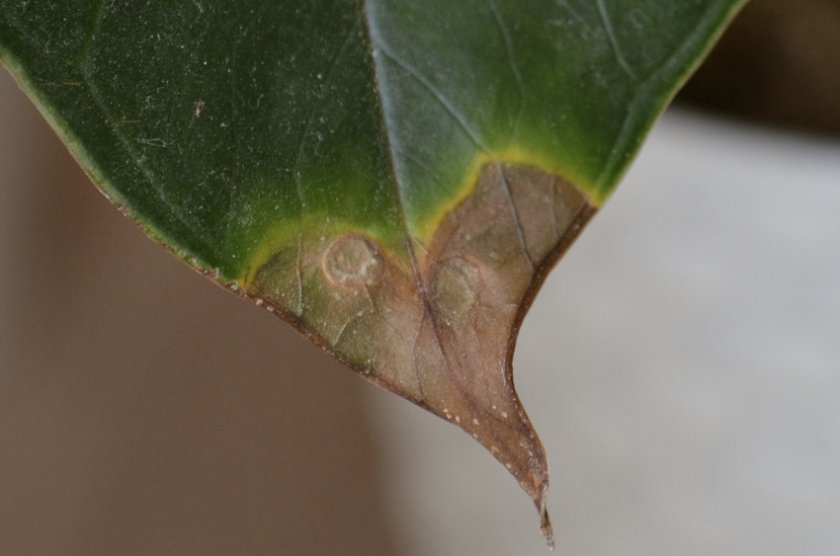Pot size discrepancy
As the plant grows, it needs room for its root system. Once a year, preferably in the spring, the anthurium is transplanted into a larger pot. For good flowering, the volume of the container should slightly exceed the size of the roots. In a large pot, it is difficult to provide the necessary and sufficient level of moisture, therefore, there is a high probability of yellowing of the leaves due to accumulated water.
When transplanting, it is important not to damage the fragile roots. If among them there are cut or damaged ones, processing is carried out with a special powder from wood ash
The container for planting must first be doused with boiling water.

First, the pot is filled with 30% drainage mixture. It can be various small stones or expanded clay. Then soil is poured for monocotyledonous flowering plants. The special breathable soil can be replaced with a mixture of turf, moss and fibrous peat soil in equal proportions.
How to care for anthurium?
So that the leaves do not turn yellow, and the flower does not hurt, the anthurium must be properly looked after.
First of all, pay attention to the quality of the water with which you water the flower. Water should be used only at room temperature (or 2 degrees higher)
After each watering of the anthurium, be sure to remove the remaining water from the pan - this is necessary so that the roots of the flower do not rot. Be sure to resize the pot as the anthurium grows
, otherwise it will be cramped for him, and the flower will soon die.
Since the flower is exotic, it loves warmth, but does not tolerate drafts. Therefore, make sure that there are no drafts in the room where the flower stands, but at the same time the supply of fresh air should be regular.
.
Remember that anthurium needs to be fed
: Feed the flower once a week in summer and once or twice a month in winter.
- Give the flower good light or partial shade. There should be enough light for the anthurium flowers to be bright and beautiful. Just try not to expose the flower to direct sunlight.
- Choose a suitable heat and humidity regime for the flower, then it will not hurt.
-
In summer, the air temperature should be at least 18 degrees Celsius, and in winter and autumn - 15-16 degrees
... If you want your anthurium to bloom faster, you can increase the temperature to 25 degrees in January. - In the summertime, try to water the flower abundantly, but do not overdo it. Spray anthurium leaves with boiled water as often as possible
.
If you follow all these rules, the leaves of the anthurium will not turn yellow, and the flower will grow and delight you with its beautiful flowers.
Anthurium is an elegant bushy houseplant with beautiful flowers. It can often be found in home collections of florists. The homeland of the plant is South and Central America, so it can be easily attributed to exotics that do not adapt too well to the conditions of northern latitudes, the atmosphere in rooms and offices.
In the process of growing, situations may arise when the bush looks bad, and its owners do not know what to do, if the leaves of the anthurium turn yellow or dry, spots appear, young shoots fall off. The cause of troubles with the exotic can be mistakes in care and uncomfortable conditions, to which the plant quickly reacts with a protest.
12 Anthurium pests
Pests appear on the flower from the outside - from other plants, sometimes already infected anthurium is brought into the house, simply without external signs of damage. Unlike fungal diseases, insect pests are much easier to spot.Anthurium is most often affected by such pests:
- 1. Aphids are small crawling insects of beige, brown or green color. It parasitizes on the underside of the leaf, multiplies rapidly and feeds on plant juices, which leads to its depletion, and in advanced cases, death.
- 2. The scabbard looks like a brown dense growth, but in fact it is an insect that tightly adheres to the trunk of the plant and feeds on its sap. The scale insect is rather large, but it is skillfully camouflaged on the trunk and in the axils of the anthurium leaves. It also lives on the inner side of the leaves, mainly near the veins.
- 3. Thrips are insects with an oblong translucent body up to 1.5 mm in length. Color - from pale gray to dark brown. Thrips are dangerous not only because they feed on anthurium sap, they spread fungal and bacterial infections, to which the tropical plant is so sensitive.
- 4. Spider mite is a small insect that is easier to notice through the fruits of its vital activity - they entangle the plant with a thin web. Yellow spots appear on the leaves, these places become thinner, which is clearly noticeable if you look at the leaf in the light.
- 5. Mealybug - an insect that looks like a scale insect, but actively moves around the plant, and does not stick tightly. Mealybug leaves a white bloom on the plants, similar to cotton wool with droplets of sticky secretions.
The appearance of insect pests on the anthurium can be seen with the naked eye.
Pest control begins with their removal. Insects are removed with a brush, toothbrush or cotton swab
The scale insects are carefully picked up with a needle so as not to damage the plant. Anthurium is thoroughly washed with soapy water, to which you can add chopped onions or garlic
The solution should not be in a strong concentration - an alkaline environment is unfavorable for anthurium. Sometimes this washing is enough. But sometimes pests go unnoticed or manage to lay eggs. To consolidate the result, insecticide preparations are used or use folk remedies.
Modern industrial insecticides have a wide spectrum of action and are used against many types of insect pests. These drugs include "Aktara", "Fitoverm", "Biotlin" and others. When working with chemicals, rubber gloves are used - all insecticides are poisonous and can irritate the skin. A day later, the plant is washed with clean water. One treatment may not be enough, after a week the trunk and leaves of the anthurium are examined for signs of pest activity. If there are suspicions, it is better to repeat the treatment. All this time, the sick anthurium is kept in quarantine so as not to infect other house plants.
As folk remedies for pest control, rubbing the plant with alcohol, calendula tincture, tobacco infusion or decoction of garlic is used. The principle of operation is the same as with purchased insecticides.
In this case, you should not follow the precautions so carefully, but the result may not be as effective.
To reduce the risk of diseases, the conditions for keeping anthurium must be observed
But it's important not to overdo it. Too high temperature and high humidity will not only weaken the plant, but will also contribute to the development of fungal or bacterial diseases.
Aging leaves of anthurium
 Like other plants, the leaves of anthuriums can turn yellow for a completely natural reason, due to old age. In such cases, the inevitable processes primarily affect the foliage located closer to the ground.
Like other plants, the leaves of anthuriums can turn yellow for a completely natural reason, due to old age. In such cases, the inevitable processes primarily affect the foliage located closer to the ground.
Yellowness, spreading from the edges of the leaf plate, gradually covers it completely, the leaf loses its elasticity and juiciness, and then turns brown. If it is not removed, such an anthurium leaf dries and falls off on its own.If the plant is kept in proper conditions, then the fall of old leaves does not damage the anthurium, because at the same time, new healthy foliage is actively appearing at the top of the stem.
Since the process is natural and inevitable, there is no need to worry about it. However, flower growers often have a question: "Is it necessary to remove yellowed or dry leaves of anthurium?"
Obviously, such leaf plates no longer perform their main function, but the plant spends certain forces on their maintenance. Therefore, it is better to cut off the leaves that have become obsolete, making life easier for the entire plant and making it more attractive.
 To prevent the cut from becoming a place for the spread of infection, it is useful to treat the cutting tool, be it scissors or a knife, with alcohol, and sprinkle the damaged tissue on the anthurium with chopped charcoal.
To prevent the cut from becoming a place for the spread of infection, it is useful to treat the cutting tool, be it scissors or a knife, with alcohol, and sprinkle the damaged tissue on the anthurium with chopped charcoal.
If the leaf still retains its juiciness, you should not tear it off by hand, because this can seriously injure the stem.
In addition to natural reasons why anthurium leaves become stained or dry, flower growers have to deal with the consequences of mistakes they made when caring for a houseplant.
Plant care rules
Anthurium is a capricious plant. Some of its species are grown only in a greenhouse.
It is also important to consider when growing a plant and the fact that its juice consists of toxins that can adversely affect the mucous membranes of a person.
Features of anthurium care:
It is recommended to grow a flower in partial shade or on a windowsill with diffused light, as it does not like bright lighting.
At the same time, it is important to provide additional lighting to the anthurium in winter. Otherwise, the plant will not sprout flower stalks.
In summer, the air temperature in the room should not exceed 25 degrees Celsius, and in winter the plant can develop at a temperature of 14-16 degrees.
To prevent the anthurium from dying, it is necessary to avoid places with drafts.
It is recommended to water the flower with slightly warm water.
In summer, watering is carried out every three days, and in winter - once every seven days. The water remaining after watering from the pan must be poured out so that the roots do not rot.
It is also important to ensure good humidity in the room where the flower is grown. Spray the leaves systematically, but in such a way that water does not get on the flowers.
Feed the anthurium twice a month with a mineral solution or organic fertilizer. It is necessary to feed during flowering and active growth of the plant.
Anthurium grows best in self-prepared soil. Mix humus (two parts) with leafy soil and peat (one part each) and sand (half part). Crushed brick or cones are added as drainage.
It is important, after purchasing the anthurium, to transplant it into a new, suitable in size, pot with the correct soil.
At home, you can propagate a plant using cuttings. Cut the cuttings from the tops of the flower along with the aerial roots. Plant them according to the rules in prepared containers.
So that the plant does not disappear, it must be protected from the attack of aphids, scale insects, fungal infections.
The danger of yellowing and drying leaves and help to the Anthurium plant
Even such a harmless symptom as a change in the color of the foliage is the first signal that something is wrong with the plant: damaged leaves are likely to die, flowering may not occur and decorativeness may be lost, or symptoms of concomitant diseases will develop.
Therefore, any changes in the appearance of a rare plant should alert a caring florist. Perhaps the cause of the problem is fairly easy to fix, but measures to save the anthurium must be taken urgently.And in case of infection with fungi, bacteria, viruses or insects, the diseased plant poses a threat to other indoor flowers that are in the neighborhood.
First aid to the plant
If a problem is found, it is important to carefully examine the stem, leaves, soil in order to find out the possible cause of the condition and provide first aid:
As soon as yellowing leaves were found on the anthurium, it is worth carefully examining the flower
Particular attention should be paid to such symptoms - spots, darkened areas of leaves and stems, any formations in the form of plaque, cobwebs, dark dots.
If, in addition to discolored leaves, no other problems are found, it is possible that the plant simply needs to change the conditions of detention, competent watering and feeding, if necessary.
In the event that there is a suspicion of a fungal disease, it is advisable to transplant the affected flower into another flowerpot using disinfected soil. Anthurium itself must be treated with special preparations or consult with specialists to accurately determine the pathogen.
Further treatment methods
Having found yellow leaves on a plant, it is worth taking turns to eliminate the most likely causes of the problem. If improving care, feeding and transplanting did not bring results, it's time to move on to decisive measures:
- before treating a sensitive flower, it is necessary to remove as much as possible damaged leaves and suspicious root areas, where pathogens may be hiding;
- it is necessary to use fertilizers and preparations recommended specifically for this type of plant;
- all plants in the room should be checked for similar symptoms in order to avoid re-infection;
- the quality of the water used for irrigation must be strictly controlled.

Even in advanced cases, there is always the opportunity to revive the anthurium from the surviving root section. But now he will need more care and attention according to all the rules.
Prophylaxis
The key to the health of such a capricious houseplant as anthurium is the observance of optimal conditions of keeping:
- prevent stagnation of moisture in the soil;
- provide a loose soil structure;
- the pot should slightly exceed the size of the root system;
- observance of the temperature regime and maintenance of the required level of air humidity;
- preventive measures for pest control.
It will also be interesting: Anthurium - reproduction and transplantation of a flower at home, male happiness?
Causes
Yellowed leaves do not always indicate that you are not properly looking after the plant. The fact is that anthurium has a natural ability to shed adults, old shoots growing in the lower part in order to accumulate strength for the emergence of young ones.

Causes, why do anthurium leaves turn yellow, maybe several. They often indicate both a violation of the rules and conditions for caring for a plant, and the appearance of harmful insects.
Leaves deteriorate and dry with improper care if:
- spraying of leaves is carried out in direct sunlight;
- not enough light in the room;
- lack of nitrogen fertilizers;
- cramped pot;
- for irrigation, hard, too cold and not settled water is used.
During the active growing season, water and fertilize anthurium regularly. The soil is moistened after 2-3 days, and top dressing is applied at least 1 time per week.

Leaves with yellow or brownish spots may indicate diseases that are recommended to be treated promptly. With excessive soil moisture and low indoor temperatures, the indoor culture can be exposed to bacterial and fungal infections.
Diseases of anthurium, due to which the leaves turn yellow:
- septoria - drafts, cold, humidity;
- rot - humid indoor air and excessive watering;
- fusarium - anthurium can become infected with the fungus from other indoor flowers or it is introduced when replacing the soil;
- chlorosis - a lack of iron and magnesium.
Anthurium can be "cured" by taking proper care if the plant has undergone a bacterial disease, and by treating it with fungicides against fungal infection. With severe yellowing, the flower needs to be urgently saved.
Major care mistakes
Anthurium can hardly be called a capricious plant, but mistakes in cultivation can be fatal for it. Here are the main signs by which you can understand that something is wrong with your plant.
Table: the main diseases of anthurium and their causes
| Signs | Causes | |||
| Diseases | Pests | Nutritional imbalance | Other reasons | |
| Leaves turn yellow | — | Spider mite, aphid | Chlorine in irrigation water |
|
| Leaves turn black | — | — | Too much calcium in the soil |
|
| Brown spots on the leaves | Septoria, rust | Aphid | — |
|
| Black spots on the leaves, brown bumps | — | Shield | — | — |
| Brown spots with a yellow rim | Septoriasis | — | — | — |
| The plant dries up | Anthracnose | — | — | Lack of moisture in the soil or air |
| Dark dots on the leaves | — | Thrips | — |
|
| Purple-brown spots on the leaves | Late blight | — | — | — |
| Yellow, faded leaves | — | — | Lack of nutrients in the soil |
|
| Pimples on the leaves | — | — | Excess watering | |
| Spiderweb coating on leaves | — | Spider mite | — | — |
| Leaves turn pale | — | — | Lack of nutrients in the soil |
|
| White chlorosis spots on the leaves | Peronosporosis | — | — | — |
| Small flowers / leaves | — | — | Lack of trace elements in the soil | Insufficient watering |
| Massive yellowing, leaf death or root rot | Fusarium wilting | — | — | Prolonged excess moisture |
| Leaves curl | — | Aphid | — |
|
| The leaves are withering | Septoriasis | Scabbard, thrips | — | — |
| Leaves "cry" after watering | — | — | — | Combination of abundant watering and moist air (guttation) |
| White bloom on the leaves | Powdery mildew | — | — | — |
| Pinkish bloom on the root collar | Fusarium wilting | — | — | — |
| Deformed leaves | — | Thrips | — | — |
| Torn leaves | — | — | — | Dry air |
| Sticky leaves | — | Shield | — | — |
| The flowers turn green | — | — | Lack of nutrients in the soil | — |
| The flowers wither | — | — | Insufficient nutrient content in the soil | Dry air |
| Pimples on the peduncles | — | Shield | — | — |
| Does not grow | — | — | Lack of nutrients in the soil |
|
| The plant withers | — | Aphids, scale insects, thrips | Lack of nutrients | Insufficient watering |
| The flower does not take root | — | Aphids, scale insects, thrips | Lack of nutrients in the soil | — |
| Anthurium trunk rotted | Fusarium wilting | — | — | Excess watering |
| The growth point rotted away | Fusarium wilting | — | — | Excess watering |
| Anthurium dries up | — | — | — |
|
| Anthurium does not bloom | — | — | — |
|
| The leg of the anthurium turns black | — | — | — | Excess watering |
| The plant is falling apart | Mycoses | — | — | Excess watering |
| Growing slowly | Damage by pests, diseases | Lack of nutrients in the soil | Lack of lighting |
Errors in caring for anthurium are usually easy to fix (rearrange the plant from the battery, water more or less, feed, change the window sill, etc.), but it is not so easy to cope with dangerous diseases and pests.
Preventive measures
One of the main precautions is to regularly check for diseases, insect pests on the anthurium. This will allow you to detect the first signs of a problem in time.
It is also recommended to carefully follow the rules of care.
It is important to create the best and most suitable conditions for the comfortable life of plants. If traces of disease are found on the surface, it is necessary to isolate the plant from other flowers to prevent spread
Observance of precautions will prevent the deterioration of the anthurium, allow you to quickly detect troubles and heal the flowers. Yellowing of leaves in anthurium can be caused not only by diseases or improper care, but also by natural processes inside the flower.
If you find this problem, you need to find the true cause, and then act immediately, do everything possible to save the houseplants.
Yellowing of leaves in anthurium can be caused not only by diseases or improper care, but also by natural processes inside the flower. If you find this problem, you need to find the true cause, and then act immediately, do everything possible to save the houseplants.



